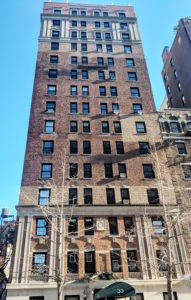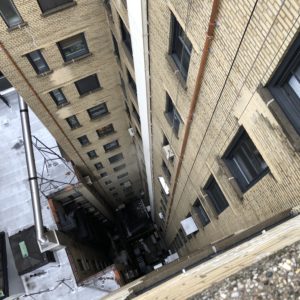
33 Fifth Avenue - Storm Drain Riser Relocation Project
Built in the 1920s, 33 Fifth Avenue is classic prewar construction. It has some old cast-iron stormwater drainage pipes that run through the building. They collect stormwater on the roof and terraces and bring it down to the cellar level to be drained out to the street. But the piping system is starting to get old. The building ran into a particularly bad problem, where one of the storm risers in an apartment line collapsed and caused significant damage to a number of units. The board was faced with a real problem: How do we address this immediately?
Normally, co-ops would open up the wall, get to the pipe and replace it. But in this case, you have well-renovated apartments so you would have to break through tile walls, custom cabinetry, closets. All four apartment lines would have to be accessed. In some cases, the piping is actually located behind other pipes, so you can't even get to it without removing other systems. So this could have meant a massive disruption to the shareholders in that building.
Responding to the Issue
We had to come up with a solution that allowed the building to still function. The question was: How do I get the stormwater down to the cellar in the most effective way? The thought process was: "Well, how about the exterior of the building? Maybe we can run the piping along the outside and therefore avoid any work inside the apartments."
It turned out to be feasible. We were able to extend the individual drains on the terraces and on the main roof above the penthouse in bulkheads down to a piping that would lead out to an external riser and down to the cellar level. We found four locations to place these risers along the off-street elevations. That became an important thing, because 33 Fifth Avenue is in a historic district. Therefore, we had to either find the identical piping or choose materials that would be acceptable to the Landmarks Preservation Commission (LPC).

Copper pipes were placed outside of the building to avoid working inside apartments.
And we had to locate positions. There are two main courtyards for 33 Fifth Avenue. The south courtyard is concealed. We found a niche in the south courtyard wall. There's a 10-footwide yard between 33 Fifth Avenue and 4 East 10th Street, where we were able to locate two other lines. Still visible from certain vantage points, but certainly not from the street. Since many other townhouses have external risers, the LPC's issue was picking an acceptable material. We had to review different material options, not just from a cost perspective, but also feasibility of installation, then longevity. We looked at different materials such as cast iron, stainless steel and copper. We ultimately agreed that copper tubing was the best option. It would discolor over time, give it that green patina.
The Result
This could have been a real hit to the co-op's capital budget - something well over half a million dollars, maybe even a million dollars when you add up all the interior costs, the disruption. We turned it into a job that ended up costing $166,000. Still a hit, but something they could actually afford to do, do quickly, and avoid going into apartments.
Watch the interview here.
Peter E. Varsalona, PE is one of RAND's Principals and MEP Team Leader.
This article was originally published in the June 2020 Issue of Habitat Magazine.
